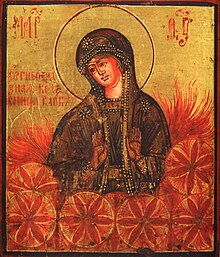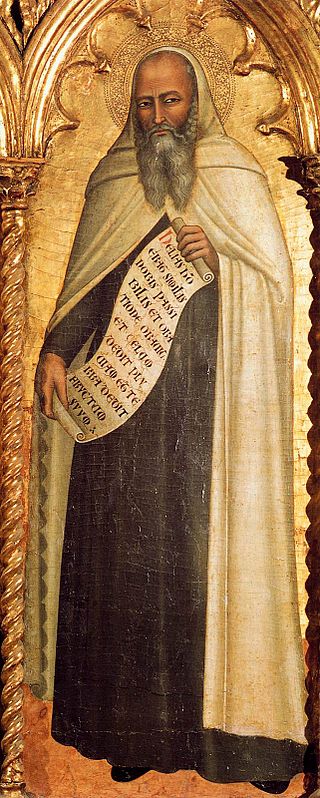
Elijah was, according to the Books of Kings in the Hebrew Bible, a prophet and a miracle worker who lived in the northern kingdom of Israel during the reign of King Ahab.

Maria, known in Serbian as Marija Karađorđević, was Queen of the Serbs, Croats and Slovenes from 1922 to 1929 and Queen of Yugoslavia from 1929 to 1934 as the wife of King Alexander I. She was the mother of King Peter II. Her citizenship was revoked, and her property was confiscated by the Yugoslav communist regime in 1947, but she was posthumously rehabilitated in 2014.
Perkunatete, Perkunatele or Perkūnėlė is in Baltic mythology the thunder goddess mother of Perkūnas, in Slavic mythology referred to as Percunatele mother of Perun, which is probably derived from the Balts. Like many such goddesses absorbed into Christianity, she is, today, difficult to distinguish from the Christian madonna, Mary, one of whose epithets was Panna Maria Percunatele. Professor Patricia Monaghan of DePaul University also believes that she was originally derived from the Baltic thunder goddess.
Mat Zemlya is the Moist Earth Mother and is probably the oldest deity in Slavic mythology besides Marzanna. She is also called Mati Syra Zemlya meaning Mother Damp Earth or Mother Moist Earth. Her identity later blended into that of Mokosh.
Perkūnas was the common Baltic god of thunder, and the second most important deity in the Baltic pantheon after Dievas. In both Lithuanian and Latvian mythology, he is documented as the god of sky, thunder, lightning, storms, rain, fire, war, law, order, fertility, mountains, and oak trees.
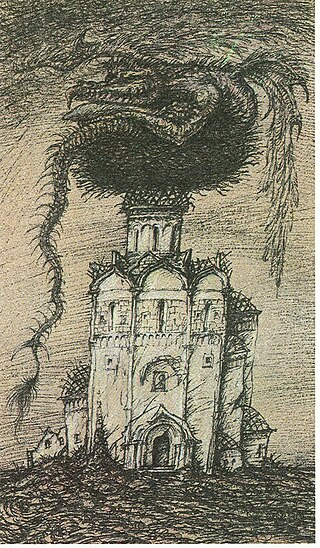
A Slavic dragon is any dragon in Slavic mythology, including the Russian zmei, Ukrainian zmiy, and its counterparts in other Slavic cultures: the Bulgarian zmey, the Slovak drak and šarkan, Czech drak, Polish żmij, the Serbo-Croatian zmaj, the Macedonian zmej (змеј) and the Slovene zmaj. The Romanian zmeu could also be deemed a "Slavic" dragon, but a non-cognate etymology has been proposed.

The Nativity of the Blessed Virgin Mary, the Nativity of Mary, Marymas or the Birth of the Virgin Mary, refers to a Christian feast day celebrating the birth of Mary, mother of Jesus.

Kupala Night is one of the major folk holidays of the Eastern Slavs that coincides with the Christian feast of the Nativity of St. John the Baptist and the East Slavic feast of Saint John's Eve. In folk tradition, it was revered as the day of the summer solstice and was originally celebrated on the shortest night of the year, which is on 21-22 or 23-24 of June, and according to Julian calendar on the night between 6 and 7 July. The name of the holiday is ultimately derived from the East Slavic word kǫpati "to bathe".

July 19 - Eastern Orthodox Church calendar - July 21
*Perkʷūnos is the reconstructed name of the weather god in Proto-Indo-European mythology. The deity was connected with fructifying rains, and his name was probably invoked in times of drought. In a widespread Indo-European myth, the thunder-deity fights a multi-headed water-serpent during an epic battle in order to release torrents of water that had previously been pent up. The name of his weapon, *ml̥dʰnis, which denoted both "lightning" and "hammer", can be reconstructed from the attested traditions.
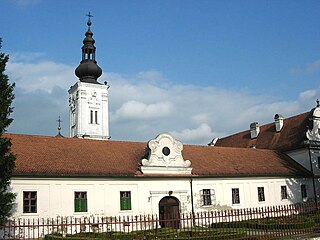
The Bođani Monastery is a Serbian Orthodox monastery in the Bačka region, in the northern Serbian province of Vojvodina. The monastery is near the village of Bođani, in the Bač municipality. Among the few Serbian Orthodox monasteries in the Bačka, Bođani is the oldest.
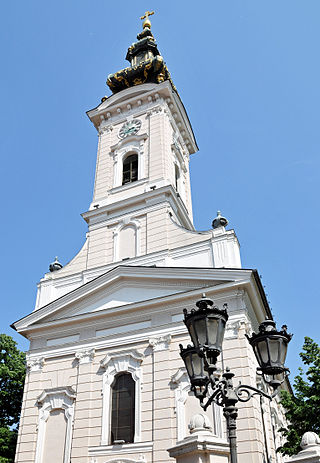
The Cathedral Church of the Holy Great-Martyr George is the seat of the Serbian Orthodox Eparchy of Bačka, located in Novi Sad, northern Serbia. The present-day church was completed in 1905, on the ruins of a church built in 1734 and destroyed in 1849. It is located next to the Eparchy offices in the Bishop's Palace, in Nikola Pašić Street. It is commonly known as Saborna crkva among the city residents.

Vasil Troyanov Boyanov, professionally known as Azis, is a Bulgarian recording artist of Romani ethnicity. Azis initially rose to prominence in Eastern Europe performing songs mostly in chalga, a genre which can be described as the Bulgarian rendition of pop-folk. Azis has collaborated with other Bulgarian pop-folk singers, such as Gloria, Malina, Sofi Marinova, Toni Storaro, and with Bulgarian rap artists – Ustata and Vanko 1. Other than that, his repertoire includes duets with singers from the former Yugoslavia, including Indira Radić, Marta Savić, Jelena Karleuša and Severina.

A zduhać and vetrovnjak in Serbian tradition, and a dragon man in Bulgarian, Macedonian and southern Serbian traditions, were men believed to have an inborn supernatural ability to protect their estate, village, or region against destructive weather conditions, such as storms, hail, or torrential rains. It was believed that the souls of these men could leave their bodies in sleep, to intercept and fight with demonic beings imagined as bringers of bad weather. Having defeated the demons and taken away the stormy clouds they brought, the protectors would return into their bodies and wake up tired.

An ala or hala is a female mythological creature recorded in the folklore of Bulgarians, Macedonians, and Serbs. Ale are considered demons of bad weather whose main purpose is to lead hail-producing thunderclouds in the direction of fields, vineyards, or orchards to destroy the crops, or loot and take them away. Extremely voracious, ale particularly like to eat children, though their gluttony is not limited to Earth. It is believed they sometimes try devouring the Sun or the Moon, causing eclipses, and that it would mean the end of the world should they succeed. When people encounter an ala, their mental or physical health, or even life, are in peril; however, her favor can be gained by approaching her with respect and trust. Being in a good relationship with an ala is very beneficial, because she makes her favorites rich and saves their lives in times of trouble.

Paraskeva of the Balkans was an ascetic female saint of the 10th century. She was born in Epivates, near present-day Istanbul, and had visions of the Virgin Mary. After living in Chalcedon and Heraclea Pontica, she settled in a convent in the desert near the Jordan River, where she died at the age of 27. The cult of Saint Paraskeva began to spread in the 14th century from Bulgaria into the Danubian Principalities of Wallachia and Moldavia. There was confusion over her identity and attributes because her Greek name "paraskevi" means "Friday," and translations in other languages, such as Romanian and Serbian, were "Saint Friday". Her cult continues to be celebrated in many Orthodox countries, and her feast day is commemorated on October 14 in the Eastern Orthodox Church.

In Slavic mythology, Perun is the highest god of the pantheon and the god of sky, thunder, lightning, storms, rain, law, war, fertility and oak trees. His other attributes were fire, mountains, wind, iris, eagle, firmament, horses and carts, and weapons. The supreme god in the Kievan Rus' during the 9th-10th centuries, Perun was first associated with weapons made of stone and later with those of metal.

The Cathedral of the Blessed Virgin Mary also called the Catholic Cathedral of Belgrade is since 1988 the cathedral church of the Roman Catholic Archdiocese of Belgrade. It is located at 75 Hadži Milentijeva Street in the Belgrade's neighborhood of Neimar, in the municipality of Vračar.

Folk Orthodoxy refers to the folk religion and syncretic elements present in the Eastern Orthodox communities. It is a subgroup of folk Christianity, similar to Folk Catholicism. Peasants incorporated many pre-Christian (pagan) beliefs and observances, including the coordination of feast days with agricultural life.
